support vector machines ML Algorithmnppt.pptx
- 2. INTRODUCTION WHAT IS SVM (SUPPORT VECTOR MACHINE) SVM is a support vector machine 1. It is supervised learning algorithms which is use for classification as well as regression problem 2. It is tor create best linear or decision boundary that can segregate and dimensional space into classes so that we can easily put new data point in correct category in future. 3. SVM choose extreme point that help in creating hyperplane. These extreme point are called support vector Types of SVM. 1.linear 2.Non- Linear MODEL TRAINING PREDICTION OUTPUT NEW DATA
- 4. BLOCK DIAGRAM FOR SVM The SVM algorithm helps to find the best line or decision boundary; 1) this best boundary or region is called as a hyperplane. 2) SVM algorithm finds the closest point of the lines from both the classes. These points are called support vectors. 3) The distance between the vectors and the hyperplane is called as margin. 4) And the goal of SVM is to maximize this margin. The hyperplane with maximum margin is called the optimal hyperplane.
- 5. ADVANTAGE & DISADVANTE OF SVM (SUPP0RT VECTOR MACHINE) Advantage 1. By the regularization parameter , user can avoid Overfitting. 2. People who have zero knowledge of data can operate easily. 3. Its highly accurate & easy to understand. 4. Its give good results, even if not enough information. 5. SVM is relatively memory efficient.
- 6. Disadvantage. 1.The first and biggest limitation depends on the choice of kernel. 2. Its speed is too low. 3. Its required more time to process. 4. Its required long training time for large data base. 5. SVM is not suitable for large date set.
- 7. EXAMPLES. 1) suppose we have a dataset that has two tags (green and blue), and the dataset has two Features x1 and x2. We want a classifier that can classify the pair(x1, x2) of Coordinates in either green or blue. Consider the below image
- 8. 2) So as it is 2-d space so by just using a straight line, we can easily separate these two classes. But there can be multiple lines that can separate these classes. Consider the below image:
- 9. 3) Hence, the SVM algorithm helps to find the best line or decision boundary.
- 10. ALGORITHAM 1. *DATA PREPARATION*: Collect labeled training data. 2. *FEATURE SCALING*: Normalize feature vectors. 3. *SELECT KERNEL*: Choose a kernel function. 4. *FORMULATE OPTIMIZATION PROBLEM*: Define objective and constraints. 5. *SOLVE OPTIMIZATION PROBLEM*: Use optimization techniques. 6. *IDENTIFY SUPPORT VECTORS*: Find closest data points to the boundary. 7. *CALCULATE DECISION BOUNDARY*: Derive the boundary equation. 8. *MAKE PREDICTIONS*: Classify new data using the boundary. 9. *REGULARIZATION (C PARAMETER)*: Balance margin and misclassification. 10. *MULTI-CLASS EXTENSION*: Adapt for multiple classes. 11. *HYPERPARAMETER TUNING*: Optimize kernel and 'C’. 12. *MODEL EVALUATION*: Assess performance using metrics
- 11. CODE












